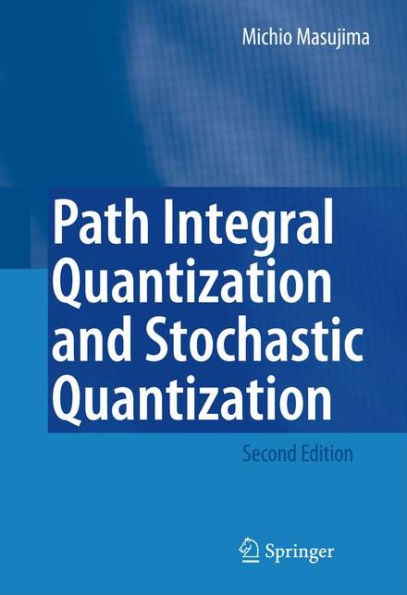Path Integral Quantization and Stochastic Quantization
In this book, we discuss the path integral quantization and the shastic quantization of classical mechanics and classical field theory. Forthe description of the classical theory, we have two methods, one based on the Lagrangian formalism and the other based on the Hamiltonian formal ism. The Hamiltonian formalism is derived from the Lagrangian·formalism. In the standard formalism ofquantum mechanics, we usually make use of the Hamiltonian formalism. This fact originates from the following circumstance which dates back to the birth of quantum mechanics. The first formalism ofquantum mechanics is Schrodinger's wave mechan ics. In this approach, we regard the Hamilton-Jacobi equation of analytical mechanics as the Eikonal equation of "geometrical mechanics". Based on the optical analogy, we obtain the Schrodinger equation as a result of the inverse of the Eikonal approximation to the Hamilton-Jacobi equation, and thus we arrive at "wave mechanics". The second formalism ofquantum mechanics is Heisenberg's "matrix me chanics". In this approach, we arrive at the Heisenberg equation of motion from consideration of the consistency of the Ritz combination principle, the Bohr quantization condition and the Fourier analysis of a physical quantity. These two formalisms make up the Hamiltonian.formalism of quantum me chanics.
1121314458
Path Integral Quantization and Stochastic Quantization
In this book, we discuss the path integral quantization and the shastic quantization of classical mechanics and classical field theory. Forthe description of the classical theory, we have two methods, one based on the Lagrangian formalism and the other based on the Hamiltonian formal ism. The Hamiltonian formalism is derived from the Lagrangian·formalism. In the standard formalism ofquantum mechanics, we usually make use of the Hamiltonian formalism. This fact originates from the following circumstance which dates back to the birth of quantum mechanics. The first formalism ofquantum mechanics is Schrodinger's wave mechan ics. In this approach, we regard the Hamilton-Jacobi equation of analytical mechanics as the Eikonal equation of "geometrical mechanics". Based on the optical analogy, we obtain the Schrodinger equation as a result of the inverse of the Eikonal approximation to the Hamilton-Jacobi equation, and thus we arrive at "wave mechanics". The second formalism ofquantum mechanics is Heisenberg's "matrix me chanics". In this approach, we arrive at the Heisenberg equation of motion from consideration of the consistency of the Ritz combination principle, the Bohr quantization condition and the Fourier analysis of a physical quantity. These two formalisms make up the Hamiltonian.formalism of quantum me chanics.
54.99
In Stock
5
1

Path Integral Quantization and Stochastic Quantization
282
Path Integral Quantization and Stochastic Quantization
282Paperback(Second Edition 2009)
$54.99
54.99
In Stock

Product Details
| ISBN-13: | 9783540878506 |
|---|---|
| Publisher: | Springer Berlin Heidelberg |
| Publication date: | 12/11/2008 |
| Edition description: | Second Edition 2009 |
| Pages: | 282 |
| Product dimensions: | 6.10(w) x 9.20(h) x 1.00(d) |
From the B&N Reads Blog
